#1. Sagrada Família

Sagrada Familia, Barcelona
Sagrada Familia – HD footage, information and facts on one of the most fascinating religious sites in the world; the Sagrada Familia. Many say that if you only have time to visit one site in Barcelona, the Sagrada Familia should be it.
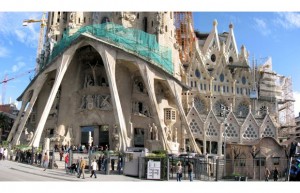 Sagrada Família Location: Barcelona, Spain Architect: Antonio Gaudi Year: 2026 (expected)
Sagrada Família Location: Barcelona, Spain Architect: Antonio Gaudi Year: 2026 (expected)
The most famous building in Barcelona and the most tremendous articulation of Gaudi’s desires, the Sagrada Família is still a living, breathing, developing building. Impossible to believe really.
The Basílica i Temple Expiatori de la Sagrada Família
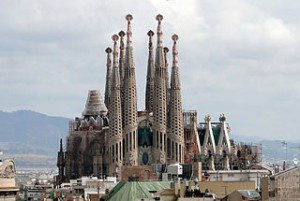 View of the Passion Façade (Western side) in September 2009
View of the Passion Façade (Western side) in September 2009
(cranes digitally removed)
(Catalan pronunciation: [səˈɣɾaðə fəˈmiɫiə]; English: Basilica and Expiatory Church of the Holy Family), is a large Roman Catholic church in Barcelona,Spain, designed by Catalan architect Antoni Gaudí (1852–1926). Although incomplete, the church is a UNESCO World Heritage Site,[5]and in November 2010 Pope Benedict XVI consecrated and proclaimed it a minor basilica, as distinct from a cathedral which must be the seat of a bishop.
Though construction of Sagrada Família had commenced in 1882, Gaudí became involved in 1883, taking over the project and transforming it with his architectural and engineering style, combining Gothic and curvilinear Art Nouveau forms. Gaudí devoted his last years to the project, and at the time of his death at age 73 in 1926 less than a quarter of the project was complete. Sagrada Família’s construction progressed slowly, as it relied on private donations and was interrupted by the Spanish Civil War, only to resume intermittent progress in the 1950s. Construction passed the midpoint in 2010 with some of the project’s greatest challenges remaining and an anticipated completion date of 2026, the centenary of Gaudí’s death.
The basílica has a long history of dividing the citizens of Barcelona, over the initial possibility it might compete with Barcelona’s cathedral, over Gaudí’s design itself, over the possibility that work after Gaudí’s death disregarded his design, and the recent proposal to build an underground tunnel of Spain’s high-speed rail link to France could disturb its stability.
Describing Sagrada Família, art critic Rainer Zerbst said, “It is probably impossible to find a church building anything like it in the entire history of art” and Paul Goldberger called it, “The most extraordinary personal interpretation of Gothic architecture since the Middle Ages.”
History
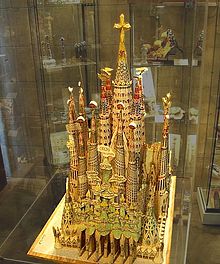 Gaudí’s model of the completed church
Gaudí’s model of the completed church
Background
The Basilica of the Sagrada Família was the inspiration of a Catalan bookseller, Josep Maria Bocabella, founder of Asociación Espiritual de Devotos de San José (Spiritual Association of Devotees of St. Joseph). After a visit to the Vatican in 1872, Bocabella returned from Italy with the intention of building a church inspired by that at Loreto. The apse crypt of the church, funded by donations, was begun 19 March 1882, on the festival of St. Joseph, to the design of the architect Francisco de Paula del Villar, whose plan was for a Gothic revival church of a standard form. The apse crypt was completed before Villar’s resignation on 18 March 1883, when Gaudí assumed responsibility for its design, which he changed radically. Antoni Gaudí began work on the church in 1883 but was not appointed Architect Director until 1884.
Construction
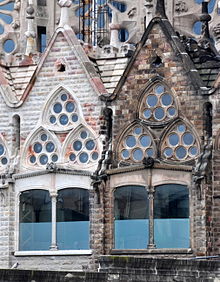 Newly constructed stonework at the Sagrada Família is clearly visible against the stained and weathered older sections.
Newly constructed stonework at the Sagrada Família is clearly visible against the stained and weathered older sections.
On the subject of the extremely long construction period, Gaudí is said to have remarked: “My client is not in a hurry.” When Gaudí died in 1926, the basilica was between 15 and 25 percent complete. After Gaudí’s death, work continued under the direction of Domènec Sugrañes i Gras until interrupted by the Spanish Civil War in 1936. Parts of the unfinished basilica and Gaudí’s models and workshop were destroyed during the war by Catalan anarchists. The present design is based on reconstructed versions of the plans that were burned in a fire as well as on modern adaptations. Since 1940 the architects Francesc Quintana, Isidre Puig Boada, Lluís Bonet i Gari and Francesc Cardoner have carried on the work. The illumination was designed by Carles Buigas. The current director and son of Lluís Bonet, Jordi Bonet i Armengol, has been introducing computers into the design and construction process since the 1980s. Mark Burry of New Zealand serves as Executive Architect and Researcher. Sculptures by J. Busquets, Etsuro Sotoo and the controversial Josep Subirachs decorate the fantastical façades.
The central nave vaulting was completed in 2000 and the main tasks since then have been the construction of the transept vaults and apse. As of 2006, work concentrated on the crossing and supporting structure for the main tower of Jesus Christ as well as the southern enclosure of the central nave, which will become the Glory façade.
Construction Status
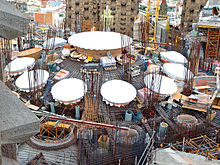 Sagrada Família’s roof under construction (2009)
Sagrada Família’s roof under construction (2009)
One projection anticipates construction completion around 2026, the centennial of Gaudí’s death—while the project’s information leaflet estimates a completion date in 2028, accelerated by additional funding from visitors to Barcelona following the 1992 Barcelona Olympics.
Computer-aided design technology has been used to accelerate construction of the building, which had previously been expected to last for several hundred years, based on building techniques available in the early 20th century. Current technology allows stone to be shaped off-site by a CNC milling machine, whereas in the 20th century, the stone was carved by hand.
In 2008, some renowned Catalan architects advocated a halt to construction, to respect Gaudí’s original designs, which, although they were not exhaustive and were partially destroyed, have been partially reconstructed in recent years.
A 2010 exhibition, Gaudí Unseen, Completing La Sagrada Família at the German Architecture Museum, Frankfurt am Main, describes the current construction methods and future plans for the Sagrada Família.
AVE Tunnel
Since 2013, AVE high-speed trains have passed near the Sagrada Família through an underground tunnel that runs beneath the centre of Barcelona.
The tunnel’s construction, which began on 26 March 2010, was controversial. The Ministry of Public Works of Spain (Ministerio de Fomento) claimed the project posed no risk to the church. Sagrada Família engineers and architects disagreed, saying there was no guarantee that the tunnel would not affect the stability of the building. The Board of the Sagrada Família (Patronat de la Sagrada Família) and the neighborhood association AVE pel Litoral (AVE by the Coast) had led a campaign against this route for the AVE, without success.
In October 2010, the tunnel boring machine reached the church underground under the location of the building’s principal façade. Service through the tunnel was inaugurated on 8 January 2013. Track in the tunnel makes use of a system by EdilonSedra in which the rails are embedded in an elastic material to dampen vibrations. No damage to the Sagrada Família has been reported to date.
http://www.complex.com/art-design/2011/02/the-top-50-architectural-achievements-of-the-modern-world/sagrada-famlia

